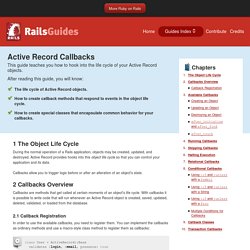

The Detailed Guide on How Ajax Works with Ruby on Rails. This is a tutorial for ajax use with Rails conventions.
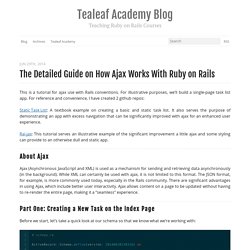
For illustrative purposes, we’ll build a single-page task list app. For reference and convenience, I have created 2 github repos: Static Task List: A textbook example on creating a basic and static task list. It also serves the purpose of demonstrating an app with excess navigation that can be significantly improved with ajax for an enhanced user experience. Rai-jax: This tutorial serves an illustrative example of the significant improvement a little ajax and some styling can provide to an otherwise dull and static app.
About Ajax. Rails Development Process Part 13 Following users. $ git checkout -b following-users A problem with the data model (and a solution) A naïve implementation of user following which is bad.

The problem with the data model in Figure 11.6 is that it is terribly redundant: each row contains not only each followed user’s id, but all their other information as well—all of which are already in the users table. Even worse, to model user followers we would need a separate, similarly redundant followers table. Finally, this data model is a maintainability nightmare: each time a user changed (say) his name, we would need to update not just the user’s record in the users table but also every row containing that user in both the followed_users and followers tables. the REST architecture involves resources that are created and destroyed. Plataformatec/devise. Rails 4 multiple image or file upload using carrierwave. Ruby Modules: What You Need to Know to Use Ruby on Rails. Since the mid-1990s, the Ruby computer programming language has become ever more popular.
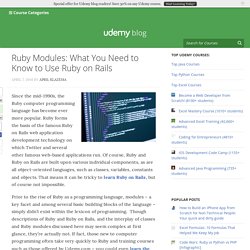
Ruby forms the basis of the famous Ruby on Rails web application development technology on which Twitter and several other famous web-based applications run. Of course, Ruby and Ruby on Rails are built upon various individual components, as are all object-oriented languages, such as classes, variables, constants and objects. That means it can be tricky to learn Ruby on Rails, but of course not impossible. Prior to the rise of Ruby as a programming language, modules – a key facet and among several basic building blocks of the language – simply didn’t exist within the lexicon of programming.
Though descriptions of Ruby and Ruby on Rails, and the interplay of classes and Ruby modules discussed here may seem complex at first glance, they’re actually not. ActiveRecord. Adds a class method for retrieving and querying objects.

A scope represents a narrowing of a database query, such as where(color: :red).select('shirts.*').includes(:washing_instructions). The above calls to scope define class methods Shirt.red and Shirt.dry_clean_only. Shirt.red, in effect, represents the query Shirt.where(color: 'red'). You should always pass a callable object to the scopes defined with scope. Plataformatec/simple_form. ActionView. Creates a form that allows the user to create or update the attributes of a specific model object.
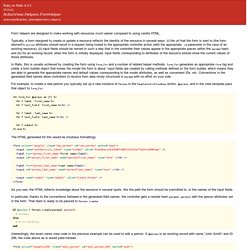
The method can be used in several slightly different ways, depending on how much you wish to rely on Rails to infer automatically from the model how the form should be constructed. Ruby on Rails Tutorial (3rd Ed.) Starting Ruby on Rails: What I Wish I Knew. Ruby on Rails is an elegant, compact and fun way to build web applications.
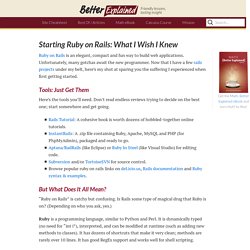
Unfortunately, many gotchas await the new programmer. Now that I have a few rails projects under my belt, here’s my shot at sparing you the suffering I experienced when first getting started. Tools: Just Get Them Here’s the tools you’ll need. Don’t read endless reviews trying to decide on the best one; start somewhere and get going. Chapter 9: Updating, showing, and deleting users. Components. Available glyphs Includes over 250 glyphs in font format from the Glyphicon Halflings set. Glyphicons Halflings are normally not available for free, but their creator has made them available for Bootstrap free of cost. Ruby on Rails Guides. Active Record Query Interface. If you're used to using raw SQL to find database records, then you will generally find that there are better ways to carry out the same operations in Rails.
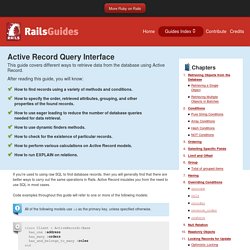
Active Record insulates you from the need to use SQL in most cases. Code examples throughout this guide will refer to one or more of the following models: All of the following models use id as the primary key, unless specified otherwise. Active Record will perform queries on the database for you and is compatible with most database systems (MySQL, PostgreSQL and SQLite to name a few). Regardless of which database system you're using, the Active Record method format will always be the same. 1 Retrieving Objects from the Database To retrieve objects from the database, Active Record provides several finder methods. Active Record Migrations. 1 Migration Overview Migrations are a convenient way to alter your database schema over time in a consistent and easy way.

They use a Ruby DSL so that you don't have to write SQL by hand, allowing your schema and changes to be database independent. You can think of each migration as being a new 'version' of the database. A schema starts off with nothing in it, and each migration modifies it to add or remove tables, columns, or entries. Active Record knows how to update your schema along this timeline, bringing it from whatever point it is in the history to the latest version. Here's an example of a migration: This migration adds a table called products with a string column called name and a text column called description. Note that we define the change that we want to happen moving forward in time. On databases that support transactions with statements that change the schema, migrations are wrapped in a transaction. Active Record Basics. 1 What is Active Record?

Active Record is the M in MVC - the model - which is the layer of the system responsible for representing business data and logic. Active Record facilitates the creation and use of business objects whose data requires persistent storage to a database. It is an implementation of the Active Record pattern which itself is a description of an Object Relational Mapping system. 1.1 The Active Record Pattern Active Record was described by Martin Fowler in his book Patterns of Enterprise Application Architecture. Active Record Callbacks. 1 The Object Life Cycle During the normal operation of a Rails application, objects may be created, updated, and destroyed.
